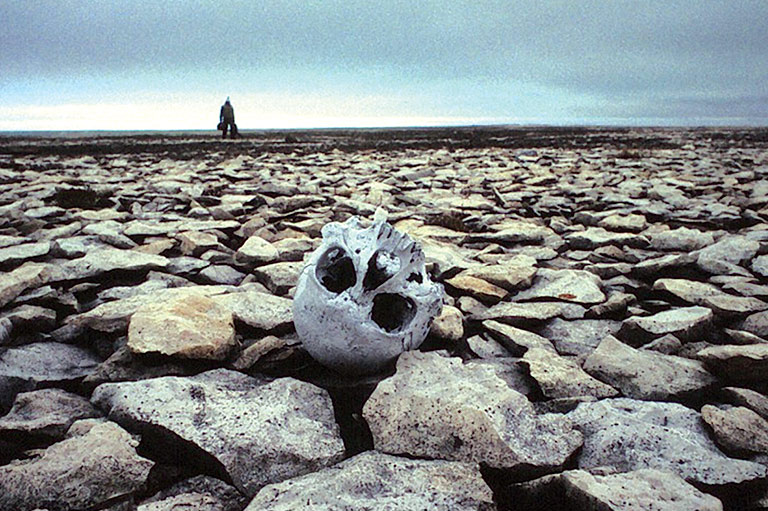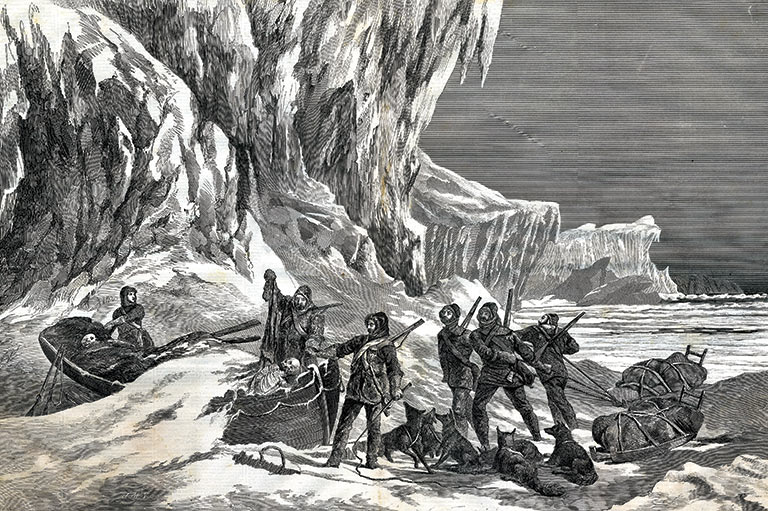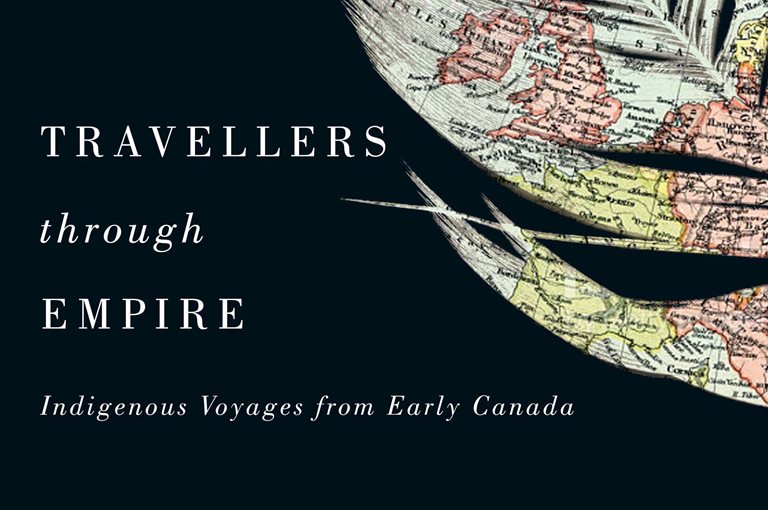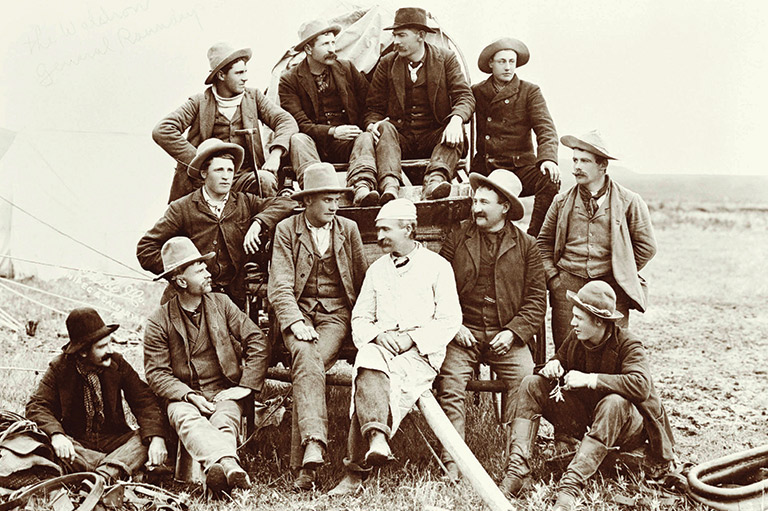Open Book: Finding Franklin

“Of all the explorers who have ever gone missing, none has inspired so long, so persistent a search as has Sir John Franklin, whose final Arctic expedition was last seen off the coast of Greenland in the summer of 1845,” writes Russell A. Potter in Finding Franklin: The Untold Story of a 165-Year Search.
When Franklin’s ships HMS Erebus and HMS Terror failed to return to Britain, their disappearance set in motion an enduring fascination with the fate of their crews as well as a series of organized searches that began in the following years.
In 1854, Arctic surveyor Dr. John Rae of the Hudson’s Bay Company returned to Britain with detailed Inuit testimony as well as relics that included pipes, watches, and even Franklin’s medal. He received the ten-thousand-pound award for “ascertaining the fate” of Franklin, but many rejected suggestions that the ships’ crews had resorted to cannibalism.
Franklin’s wife, Lady Jane Franklin, sponsored several searches for the party, including one led by Francis Leopold McClintock, who returned in 1859 with records that confirmed John Franklin’s death on June 11, 1847, but indicated neither a cause of death nor a final resting place. Her efforts are credited with maintaining initial interest in the expedition’s fate, but since then many others have caught the Franklin search bug.
With 7 uniquely curated newsletters to choose from, we have something for everyone.
Inspired Expedition
Barry Ranford was a photographer and high school art teacher in Palgrave, Ontario, about forty miles northwest of Toronto. He lived by himself in a converted gristmill far from town, where he had rigged up a turbine in the old millrace so he could generate his own electricity. Like Charles Francis Hall before him, he had little background or prior history of Arctic interest, no training as a historian or archaeologist, and no knowledge of Inuit culture. Yet, to many, he became the most significant figure in the search for traces of Franklin since Rae. It was his search, after all, that led to the recovery of the largest modern cache of Franklin remains and physical artifacts, including the bones that corroborated earlier findings of lead poisoning, and provided — most significantly — clear evidence that the final survivors had indeed turned to cannibalism. And, although his death by suicide a few years after his first discoveries ended his own career as a searcher, he influenced a generation of amateur Franklin detectives who continued to visit King William Island for nearly a decade afterwards.
It was, by some accounts, a book given to him by his son that started Ranford’s Franklin obsession; no one seems to recall which book, but I like to imagine that it was McClintock’s Voyage of the ‘Fox’ in the Arctic Seas. Whatever it was, Ranford was soon devouring every book about Franklin he could get his hands on, and when researcher David Woodman’s account of the Inuit evidence was published in 1991, he read it with tremendous interest. He was particularly struck by the accounts of Franklin’s men as they struggled southward down the coast of King William Island. How could the remains of so many have gone missing? Where was In-nook-poo-zhee-jook’s second boat, the one filled with bones, or the skeletons reburied by Frederick Schwatka? And then there was the large tent full of bodies described in the Inuit testimony — had it been a sort of field hospital for those too ill to carry on? Surely some trace of such a place must still remain.
And so, in the summer of 1992, Ranford, along with his former photography student Mike Yarasavich, flew up to King William. They brought their supplies with them in backpacks and a sort of modified garden cart with heavy-duty wheels, which they planned to haul down the entire western coast of the island, watching the ground beneath their feet, looking for any traces of Franklin’s men. They found the going rougher than they had realized, and the plan almost went awry a week into their trek when Yarasavich came down with flu-like symptoms; for a time, Ranford had to haul him in the cart. Eventu-ally, as they neared the area of Erebus Bay, where Schwatka had found the three skeletons, Ranford just let Yarasavich sleep at their camp and used the time to pace back and forth, his gaze unrelentingly directed at the ground. The surface there — bro-ken limestone, gravel, and patches of thin soil that supported only moss and lichen — was monotonous in the extreme; every-where one looked, it seemed the same. It was no wonder, Ranford realized, that so few had found any remains before.
It was on almost the last day, when the two men would have to leave in order to meet their plane at Gjoa Haven, that Ranford spotted it. In his own words: “Retracing a line for a second time, I saw from a distance what looked like a bleach bottle. A bleach bottle on the western side of King William Island made little sense, and as I moved forward, increasingly transfixed, the bottle resolved into a human skull bleached white by time. Then suddenly, I became aware of another skull close by. And then another. I was surrounded by bones. Femurs, a pelvis, two jawbones, and part of a vertebra lay white on the rocky limestone, or half-buried, protruding through a carpet of dark green moss.” Although he didn’t realize it quite yet, what Ranford had stumbled upon was almost certainly In-nook-poo-zhee-jook’s place of bones. Not being an anthropologist, though, he hesitated. These might be Inuit bones, after all — how could he be sure? And then something else caught his eye: “It was deeply embedded in moss, and it was warped and covered with a yellow lichen that almost camouflaged its true nature — a machine-stitched boot sole with a square, Victorian-style toe, the footwear of some unlucky sailor.”
Save as much as 40% off the cover price! 4 issues per year as low as $29.95. Available in print and digital. Tariff-exempt!

There could be little doubt that these, then, were Franklin-era remains. He stayed as long as he could, searching the ground for some more absolute evidence, and spotted bits of rope, nails, grommets, and small fragments of wood. These, he realized, could well be the remains of a boat with a sail, its planks long ago carried off by Inuit. Further searching revealed a pattern: Here, on a slightly elevated island surrounded by tidal mud, a boat had lain; there, up a slight slope, was a stretch of level ground that might have been a tent place. The more widely scattered bones seemed to be partway down the slope; perhaps these were individuals who had died when their comrades were still able to drag them outside. Another cluster of remains nearer to where the boat had been suggested that this site, too, had served as a shelter for a time.
Lastly, he stumbled on a tiny, gilt brass button, bearing an anchor, rope, and crown. This he took with him, and later brought to the National Maritime Museum in London, where it was authenticated as matching those of Franklin’s officers; there could be no doubt now. The only problem was how to investigate the site further. Ranford knew that, under the law, he could not touch or remove these remains without a permit and an archaeologist present. Yet, were he to simply report his findings, it was unlikely that anyone would actually come to investigate them. Funding, and time, were limited in the North, and his report might well be classed as just another account of a miscellaneous Franklin site with nothing new to recommend it. And so he tried a different tactic: He called the Prince of Wales Northern Heritage Centre — the agency then responsible for the site, since it lay in the Northwest Territories — and made them an offer that was hard to refuse: Either come and examine this spot or he would just go ahead and do it himself, permit or no permit. Ranford’s gambit — some might call it blackmail — succeeded, and with assistance from the Polar Continental Shelf organization, an archaeological team was sent to the area the following summer.
Ranford was there to meet them; on this trip, he brought along his daughter Jennifer as well as John Harrington, the vice-principal at his high school, who had both caught his Franklin fever. Yet, even when he took them to the exact spot, the archaeological team — Margaret Bertulli and Anne Keenleyside — had a hard time seeing the bones. Ranford explained: his trick was to put himself in the mind of a starving Franklin sailor, scouring the land for something to gnaw on. And then, just as had happened when he first found the bones, the others began to see them: one, two, and then many. In all, excluding bones of seals and other Arctic fauna, they would find more than four hundred. Quite a few of the large bones were broken, just as the Inuit had said, and there were visible cut marks on many others. Later, using a scanning electron microscope, Keenleyside would confirm that these were deep, clear-edged cuts, made by a sharpened metal blade. They were located at points where the large muscles joined the bone, the very places where someone intent on defleshing a body would have cut.
Advertisement
Some people refuse to believe that cannibalism could have occurred. They point to the numerous cuts on the small bones of the hands and suggest that these may be defensive wounds, made by men attempting to fend off an attack. The location and number of these cuts, however, is inconsistent with such a scenario; according to Keenleyside, these show either an attempt to remove the hands altogether — something the Inuit testified to having seen elsewhere — or perhaps to amputate fingers that had been lost to frostbite. Despite this, there are still some who, like Ernie Coleman, argue as did Charles Dickens that the Inuit set upon Franklin’s innocent men. It suffices to me that, at the National Maritime Museum in Greenwich, whose shrine to Franklin includes the Victory Point record, Franklin’s medal, spoons, and other relics, the caption is clear: “Several bones of Franklin’s men have been found that have knife-scratches and marks on them that are usually associated with cannibalism. This is a normal resort of desperate humans, but the suggestion that the last of Franklin’s men ate their dead companions was hotly rejected by Victorian society.”
While at the spot, the searchers also identified, with Ranford’s help, several nearby areas of human remains, including one that they designated NgLj-3, the site of three disturbed graves and at least two skulls; … even as the archaeologists did their work, though, Ranford wandered farther and farther afield; he told some of them he was looking for the “hospital site,” where he believed that, at least for a time, those members of the expedition who were too weak to continue were cared for. They cautioned him not to touch or remove any remains he might find, then went back to their work. The season for such work is short in the Arctic, and neither they nor he felt that the opportunity should be wasted.
From Finding Franklin: The Untold Story of a 165-Year Search, by Russell A. Potter. Reprinted with permission of McGill-Queen’s University Press (2016).
At Canada’s History, we highlight our nation’s past by telling stories that illuminate the people, places, and events that unite us as Canadians, while understanding that diverse past experiences can shape multiple perceptions of our history.
Canada’s History is a registered charity. Generous contributions from readers like you help us explore and celebrate Canada’s diverse stories and make them accessible to all through our free online content.
Please donate to Canada’s History today. Thank you!
Themes associated with this article
Advertisement
You might also like...

Our online store carries a variety of popular gifts for the history lover or Canadiana enthusiast in your life, including silk ties, dress socks, warm mitts and more!










